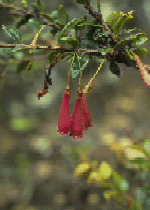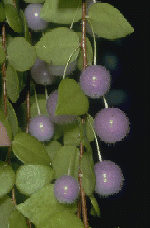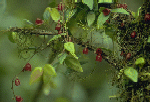- 18. Sphyrospermum POEPPIG & ENDLICHER Nov. Gen. Sp. Pl. 1: 4 (1835). --Lectotype:
- Sphyrospermum buxifolium POEPPIG & ENDLICHER.
- Sophoclesia KLOTZSCH, Linnaea 24: 15, 29 (1851). Type: not cited.
Reference: SMITH, A. C., The genera Sphyrospermum
and Disterigma.
Brittonia 1(4): 203--232 (1933).




Slender, often straggly, epiphytic or terrestrial shrubs with pendent branches. Leaves
alternate, coriaceous, sometimes very thickly so, often brittle, usually small and
obscurely nerved, subsessile. Inflorescence axillary, flowers solitary or rarely
paired in axils of the leaves; pedicel slender, cernuous, distally swollen; bracteoles
2, deciduous. Flowers 4--5-merous, without odor; aestivation apparently valvate;
calyx continuous with the pedicel; hypanthium subglobose or obconic; limb suberect; corolla campanulate, cylindric (tubular), to infundibuliform; stamen usually as
many or twice as many as the corolla lobes, equal or alternately slightly unequal;
filaments distinct, usually longer than anther, lacking spurs, usually somewhat
sigmoid at the base; anther inserted dorsally near base, membranous, smooth, lacking disintegration
tissue; tubules distinct, as long as or longer than the thecae, dehiscing by oval
clefts; pollen lacking viscin threads; nectariferous disc annular-pulvinate, but not apparent; ovary inferior, 4--5-locular, the partitions soon decaying; stigma
truncate; style filiform, about as long as corolla. Fruit a subglobose or ellipsoid,
juicy berry, translucent white to lavender or purplish, glabrous or pubescent, when immature the pericarp dry and brittle, when mature thin and papery; ovules numerous,
the placentation axile but often appearing central or even basal; seeds elongate,
striate, the embryo green and clearly visible through the endosperm.
Sphyrospermum
is a genus of about 22 species, which ranges from southern Mexico through the highlands
of Central America and the Andes of South America to Bolivia and east to French Guiana,
and in the Caribbean from Haiti to Trinidad.
Key to Species of Sphyrospermum
- 1a.
- Corolla tiny, less than 4 mm long.
- 2a.
- Stamen 4; leaves suborbicular-elliptic, (1.5-) 2--4 cm long; pedicel 5--9 mm
long
- .......................................................................................S. ellipticum
- 2b.
- Stamen 8--10; leaves orbicular to ovate-elliptic, 0.5--1.3 x 0.4--0.8 cm; pedicel
to 4 mm long.
- 3a.
- Flowers 5-merous, subsessile, pedicel less than 1 mm long; corolla hispid in
distal 1/2--1/3, cylindric-campanulate, the throat open and spreading; leaves 10--13
x 6--8 mm
- ..............................................................................S. spruceanum
- 3b.
- Flowers 4-merous, obviously pedicellate, pedicel 3--6 mm long; corolla glabrous,
cylindric, the throat narrowed and contracted; leaves 5--8 x 4--6 mm long
- ..............................................................................S. microphyllum
- 1b.
- Corolla larger, equal to or greater than 4 mm long (if 4 mm long, then pedicel
> 15 mm long).
- 4a.
- Corolla campanulate, the throat broad and spreading.
- 5a.
- Corolla yellow, ca 5--5.5 mm long; anther tubules much longer than thecae, dehiscing
by oblique, subterminal pores.
- ..............................................................................S. flaviflorum
- 5b.
- Corolla dark red, 8.5--12 mm long; anther tubules equal to or shorter than thecae,
dehiscing by perfectly terminal pores.
- 6a.
- Flowers 4-merous; pedicel 1--4 (-8) mm long; leaves apically acute to rounded;
anther tubules about equalling thecae, ca 1.6--2.5 mm long; berry quadrangular
- .....................................................................S. dissimile
- 6b.
- Flowers 5-merous; pedicel 10--15 mm long; leaves apically obtuse-mucronate;
anther tubules < thecae, ca 0.5--0.6 mm long; berry ellipsoid
- ....................................................................S. campanulatum
- 4b.
- Corolla cylindric to cylindric-urceolate or cylindric-infundibuliform, the throat
obviously contracted.
- 7a.
- Corolla equal to or greater than 12 mm long, the lobes strongly reflexed at anthesis
so as to expose stamens (mature corolla unknown in S. musicolum
).
- 8a.
- Leaves pellucid, veinlets clearly visible, very acute at apex, about as long as
broad, 20--30 x 20--23 mm; stamen 10, with filaments slightly longer than anthers;
calyx lobes ca 1.5 mm long, tufted-pilose at tip; pedicel 15--20 mm long; corolla red, pilose distally, 12--20 mm long
- .....................................................................S. musicolum
- 8b.
- Leaves coriaceous, opaque, veinlets obscure, long- to short-acuminate at apex,
noticeably longer than broad; stamen 8--10, with filaments about two times anther
length.
- 9a.
- Leaves narrowly ovate-lanceolate, very long-acuminate; flowers 5-merous; E Ecuador
- ............................................................S. lanceolatum
- 9b.
- Leaves ovate to broadly ovate, short- to long-acuminate; flowers 4-merous; W
Ecuador.
- 10a.
- Leaves 1--3.5 (-4.3) x 0.5--1.5 (-1.8) cm; corolla infundibuliform, moderately
to densely short-hirsute; filaments 13--15 mm long, densely pilose; flowers conspicuously
extending beyond the subtending leaf; calyx densely to sparsely puberulent
- ...................................................S. boekei
- 10b.
- Leaves (2.6-) 3--7 (-8.5) x (1.6-) 2.5--3.5 cm; corolla tubular, broadened above
middle, usually glabrous; filaments 9--15 mm long, usually glabrous; flowers not
extending beyond but instead usually slightly hidden by the subtending leaves; calyx usually glabrous
- ...................................................S. grandifolium
- 7b.
- Corolla equal to or less than 12 mm long, the lobes not so strongly reflexed as
to expose stamens at anthesis.
- 11a.
- Pedicel 6--10 mm long, the flowers hidden by the leaves.
- 12a.
- Corolla tubular, broadest above the middle, 9--12 mm long, hispid, red with lobes
blue-black (even when dry); leaves 1--3 cm long, succulent and brittle when fresh
but drying thin-coriaceous with the lower surface strongly wrinkled; calyx hispid, the lobes acuminate, 0.6--0.8 mm long; stamen alternately unequal, the filaments
longer than anthers, 5.5--7.5 mm long
- ............................................................S. sodiroi
- 12b.
- Corolla urceolate, ca 6 mm long, glabrous, pale yellow, the lobes not black;
leaves (2-) 2.5--4 cm long, succulent when fresh and drying thick-coriaceous, concave,
often revolute, and with the midrib often strongly carinate; calyx short white pilose to villous, the lobes deltate, short-acuminate, 0.6--1 mm long; filaments shorter
than anthers, 1--1.5 mm long
- ............................................................S. haughtii
- 11b.
- Pedicel (10--) 12--25 mm long.
- 13a.
- Leaves suborbicular, (0.7-) 0.9--1.5 (-1.8) cm long, the apex rounded; flowers
extending well beyond the leaves; mature corolla 4--5.5 mm long (rarely 6 mm), white
to pinkish; stamens 4
- ............................................................S. buxifolium
- 13b.
- Leaves ovate to ovate-lanceolate, usually conspicuously longer than broad, (1-)
2--13 cm long, the apex obtuse to sharply long-acuminate; flowers rarely extending
beyond the leaves; mature corolla 5--9.5 mm long (rarely less), white to dark red; stamens 4--5 or 8--10.
- 14a.
- Leaves broadly to narrowly ovate, (1-) 2--3.5 (-5) x (-.8) 1.5--2.5 (-3) cm,
the apex obtuse or rounded to acute, sometimes shortly and bluntly acuminate; corolla
(4-) 5--7 (-9) mm long; stamens 4--5 or 8--10
- ...................................................S. cordifolium
- 14b.
- Leaves ovate-lanceolate, (8-) 10--13 x 4--5 cm, the apex (usually sharply) long-acuminate;
corolla ca 9.5 mm long; stamens 10
- ...................................................S. longifolium



